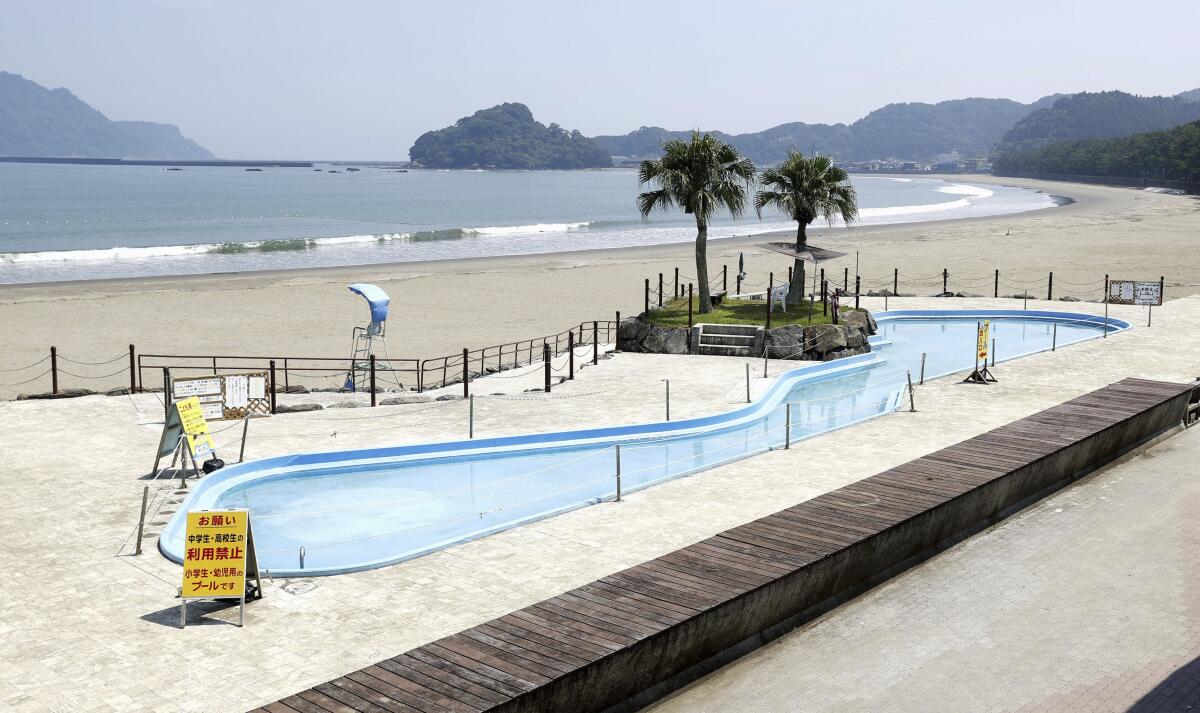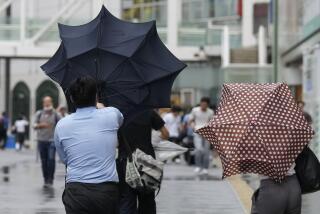Japan’s first-ever ‘megaquake advisory’ brings worry and confusion. What does it mean?

- Share via
TOKYO — Japan, one of the most earthquake-prone nations on Earth, issued its first-ever “megaquake advisory” last week after a powerful quake struck off the southeastern coast of the southern main island of Kyushu.
The magnitude 7.1 quake caused no deaths or severe damage, but the advisory has led to widespread confusion and a lingering sense of worry — in a country well accustomed to regular quakes — about when the next big one will hit.
A look at what the advisory means, what people are being told to do, and what could happen if a massive quake hits Japan.
What is a megaquake advisory?
The Japan Meteorological Agency issued the advisory after concluding that the magnitude 7.1 quake that struck on Aug. 8 on the western edge of the Nankai Trough increased the likelihood of a stronger one.
There is a 70-80% chance of a magnitude 8 or 9 quake associated with the Nankai Trough within the next 30 years, and the probability is now “higher than normal” after the latest quake, the agency said.
But that is not a prediction that a megaquake will happen at any specific time or location, says University of Tokyo seismologist Naoshi Hirata, who heads the agency’s experts panel. He urged people to remain cautious and prepared.
What is the Nankai Trough?
The Nankai Trough is an undersea trench that runs from the Hyuganada Sea, off the southeastern coast of Kyushu, to Suruga Bay in central Japan. It spans about 500 miles along the Pacific coast.
The Philippine Sea Plate there slowly pulls down on the Eurasian Plate and causes it to occasionally snap back, an action that could lead to a megaquake and tsunami, the Japan Meteorological Agency said.
The last Nankai Trough quake off Shikoku in 1946 recorded a preliminary magnitude of 8.0 and killed more than 1,300 people.
How damaging can a megaquake be?
In 2013, a government disaster prevention team said a magnitude 9.1 Nankai Trough quake could generate a tsunami exceeding 30 feet within minutes, killing as many as 323,000 people, destroying more than 2 million buildings and causing economic damage of more than $1.5 trillion to large swaths of Japan’s Pacific coast.
What is the government doing to prepare?
As a result of the megaquake advisory, Japanese Prime Minister Fumio Kishida canceled his planned Aug. 9-12 trip to Central Asia and announced he would lead the government response and ensure preventive measures and communication with the public.
Japan’s Fire and Disaster Management Agency instructed 707 municipalities seen as being at risk from a Nankai Trough quake to review their response measures and evacuation plans.
Experts and officials have urged people to stay calm and carry on their daily social and economic activities while also securing emergency food and water and discussing evacuation plans with family members.
In a reassuring note on Monday, Japan Meteorological Agency experts said they had found no abnormal seismic or tectonic activity that would indicate a megaquake.
How are people reacting?
The megaquake advisory, which is filled with scientific jargon, has worried and baffled people across the country. Some towns closed beaches and canceled annual events, which has led to challenges for travelers during Japan’s Obon holiday week, a time for festivals and fireworks across the nation.
Many people have put off planned trips and rushed to stock up on rice, dried noodles, canned food, bottled water, portable toilets and other emergency goods, leaving shelves empty at many supermarkets in western Japan and Tokyo, even though the capital is outside the at-risk area.
The Summit supermarket chain said microwavable rice is in short supply and the store is limiting purchases to one pack per customer.
Yoshiko Kudo and her husband, Shinya, said they had trouble understanding what exactly the advisory meant, how worried they should be and what they should do.
“We are trying not to go overboard. Too much worry is not good,” Yoshiko said.
“We don’t know how to be prepared and to still live normally like the experts tell us,” said Shinya, a caregiver in his 60s.
Yoneko Oshima, walking by a major train station in Tokyo, said: “It’s scary. ... They say there’s a [70-80%] chance in the next 30 years, but it could be tomorrow.” Her latest purchase is a portable toilet. She says water is indispensable for her diabetic husband, who needs to take medicine after every meal.
“I plan to take this opportunity to make a list and make sure we have everything at hand,” Oshima said. She hasn’t changed her holiday plans this week, but her daughter canceled a planned trip to Mt. Fuji.
In Matsuyama city on the island of Shikoku, which has many hot springs, hotels and resorts reviewed their evacuation procedures and emergency equipment and launched a radio communication system for emergency use. They have received hundreds of cancellations since the advisory was issued, said Hideki Ochi, director of the Dogo Onsen Ryokan Assn.
Rail companies serving the region said their trains are operating at slightly reduced speeds as a precaution.
A crisis management task force in the coastal town of Kuroshio in Kochi prefecture, where a tsunami as high as 111 feet was predicted in the government risk analysis, initially set up 30 shelters across town. But only two are still open following Monday’s statement that there has been no indication of an impending megaquake.
The town of Higashiosaka’s website urged residents not to engage in “unnecessary and non-urgent” travel in case of a major quake.
The popular seaside town of Shirahama in Wakayama prefecture said its four outdoor hot springs, parks and other facilities would be closed for a week. Saturday’s annual fireworks festival was also canceled.
Yamaguchi writes for the Associated Press.
More to Read
Sign up for Essential California
The most important California stories and recommendations in your inbox every morning.
You may occasionally receive promotional content from the Los Angeles Times.










